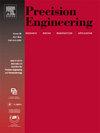Boundary-tailored flow and electric fields in electrochemical milling: Experimental and numerical simulation
IF 3.5
2区 工程技术
Q2 ENGINEERING, MANUFACTURING
Precision Engineering-Journal of the International Societies for Precision Engineering and Nanotechnology
Pub Date : 2025-02-03
DOI:10.1016/j.precisioneng.2025.02.002
引用次数: 0
Abstract
Sinking electrochemical milling refers to a process where the electrode is positioned below the workpiece's surface. The primary advantage of this technique lies in its capacity to eliminate surface irregularities of the blank workpiece, enhance processing depth with a single electrode, and effectively control the reflection and flow of the electrolyte by allowing the tool electrode to sink, thereby improving machining accuracy. To address the issue of electrolyte products accumulating in the processing gap during sinking electrochemical milling, this paper introduces a novel processing method called semi-sinking electrochemical milling. This method combines the advantages of both flying and sinking electrochemical milling. In semi-sinking electrochemical milling, rectangular electrode leading edge performs flying electrochemical milling, while the trailing edge engages in sinking electrochemical milling by cutting into the workpiece. To enhance the effective processing area of the electrode's trailing edge in semi-sinking electrochemical milling, a electrode with an inclined leading edge was designed and validated. Through physical field distribution analysis, the impact of leading edge inclination angle is studied. Results indicate that increasing the leading edge inclination angle mitigates the liquid deficiency phenomenon. A higher inclination angle results in a more uniform flow field, which boosts the leading edge current density. Experimental findings demonstrate that the material removal rate is 169.90 % higher than that of standard sinking electrochemical milling electrode when the electrode is inclined angle to 60°.Additionally, there is a 121.45 % increase in the material removal rate and a 102.97 % increase in processing depth, along with a steeper section profile, compared to the standard cutting electrode with a 60° inclination angle. From a surface morphology perspective, using a electrode with an inclined leading edge reduces stray corrosion on the processed surface and achieves superior surface finish quality.

电解铣削中的边界定制流动和电场:实验和数值模拟
下沉电化学铣削是指电极位于工件表面以下的加工过程。该技术的主要优点在于能够消除毛坯工件表面的不规则性,提高单电极的加工深度,并通过允许工具电极下沉有效地控制电解液的反射和流动,从而提高加工精度。针对电解铣削过程中电解产物在加工间隙中积累的问题,提出了一种新型的半电解铣削加工方法。该方法结合了飞磨和沉磨的优点。在半下沉电化学铣削中,矩形电极前缘进行飞向电化学铣削,后缘通过切入工件进行下沉电化学铣削。为了提高半下沉电解铣削中电极后缘的有效加工面积,设计并验证了一种倾斜前缘电极。通过物理场分布分析,研究了前缘倾角的影响。结果表明,增大前缘倾角可以缓解缺液现象。倾角越大,流场越均匀,前缘电流密度越大。实验结果表明,当电极倾斜60°时,材料去除率比标准下沉电化学铣削电极高169.90%。此外,与具有60°倾角的标准切割电极相比,材料去除率增加了121.45%,加工深度增加了102.97%,断面轮廓更陡峭。从表面形貌的角度来看,使用具有倾斜前缘的电极减少了加工表面的杂散腐蚀,并获得了卓越的表面光洁度。
本文章由计算机程序翻译,如有差异,请以英文原文为准。
求助全文
约1分钟内获得全文
求助全文
来源期刊
CiteScore
7.40
自引率
5.60%
发文量
177
审稿时长
46 days
期刊介绍:
Precision Engineering - Journal of the International Societies for Precision Engineering and Nanotechnology is devoted to the multidisciplinary study and practice of high accuracy engineering, metrology, and manufacturing. The journal takes an integrated approach to all subjects related to research, design, manufacture, performance validation, and application of high precision machines, instruments, and components, including fundamental and applied research and development in manufacturing processes, fabrication technology, and advanced measurement science. The scope includes precision-engineered systems and supporting metrology over the full range of length scales, from atom-based nanotechnology and advanced lithographic technology to large-scale systems, including optical and radio telescopes and macrometrology.

 求助内容:
求助内容: 应助结果提醒方式:
应助结果提醒方式:


